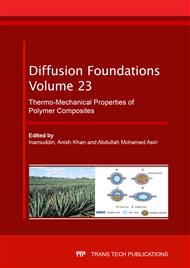[1]
Bhargava, A.K. Engineering Materials; PHI Learning Private Limited: New Delhi, (2011).
Google Scholar
[2]
Bhosale, S.K.B.; Pawade, R.S.; Brahmankar, P.K. Effect of process parameters on MRR, TWR and surface topography in ultrasonic machining of alumina-zirconia ceramic composite. Ceramics International 2014, 40, 12831–12836.
DOI: 10.1016/j.ceramint.2014.04.137
Google Scholar
[3]
M. Rosso, Ceramic and metal matrix composites: route and properties, Journal of Materials Processing Technology · June 2006,.
DOI: 10.1016/j.jmatprotec.2005.04.038
Google Scholar
[4]
Y. Liang, S. P. Dutta, Technovation 21, 2001, 61–65.
Google Scholar
[5]
Kaya, H. The application of ceramic-matrix composites to the automotive ceramic gas turbine. Composites Science and Technology 1999, 59, 861–872.
DOI: 10.1016/s0266-3538(99)00016-0
Google Scholar
[6]
Chawla, K.K. The high-temperature application of ceramic-matrix composites. International Journal of Minerals, Metallurgy, and Materials 1995, 47 (12), 19–21.
Google Scholar
[7]
Colombo, P.; Sglavo, V.; Pippel, E.; Woltersdorf, J. Joining of reaction-bonded silicon carbide using a preceramic polymer. Journal of Materials Science 1998, 33, 2405–2412.
DOI: 10.1023/a:1004312109836
Google Scholar
[8]
Lim, D.S.; You, D.H.; Choi, H.J.; Lim, S.H.; Jang, H. Effect of CNT distribution on tribological behavior of alumina-CNT composites. Wear 2005, 259 (1–6), 539–544.
DOI: 10.1016/j.wear.2005.02.031
Google Scholar
[9]
Jianxin, D.; Taichiu, L. Surface integrity in electro-discharge machining, ultrasonic machining and diamond saw cutting of ceramic composites. Ceramics International 2000, 26, 825–830.
DOI: 10.1016/s0272-8842(00)00024-9
Google Scholar
[10]
Cho, J.; Boccaccini, A.R.; Shaffer MSP. Ceramic matrix composites containing carbon nanotubes. Journal of Materials Science 2009, 44, 1934- (1951).
DOI: 10.1007/s10853-009-3262-9
Google Scholar
[11]
Rahaman, M.N. Ceramic Processing and Sintering. Marcel Dekker: New York, Second Edition, (2003).
Google Scholar
[12]
Maitra, S. Advances in Ceramic Matrix Composites. Woodhead Publishing Limited: Cambridge, (2014).
Google Scholar
[13]
Dariel, M.P.; Frage, N. Reaction bonded boron carbide: recent developments. Advances in Applied Ceramics 2012, 111 (5&6), 301–310.
DOI: 10.1179/1743676111y.0000000078
Google Scholar
[14]
Weimer, A.; Besmann, T.; Stinton, D.; Lowden, R.; Lee, W. Carbide. Nitride Boride Material Synthesis Process; Chapman & Hall: New York, 1997; 547–577.
DOI: 10.1007/978-94-009-0071-4_22
Google Scholar
[15]
Lazzeri, A. CVI Processing of Ceramic, Ceramics and Composites Processing Methods. John Wiley & Sons Inc.: Hoboken, NJ; 2012, 313–349.
DOI: 10.1002/9781118176665.ch9
Google Scholar
[16]
Yi, J.; Xue, W.J.; Xie, Z.P.; Chen, J.; Zhu, L. A novel processing route to develop alumina matrix nanocomposites reinforced with multi-walled carbon nanotubes. Materials Research Bulletin 2015, 64, 323–326.
DOI: 10.1016/j.materresbull.2015.01.017
Google Scholar
[17]
Wang, F.C.; Zhang, Z.H.; Sun, Y.J.; Liu, Y.; Hu, Z.Y.; Wang, H.; Korznikov, A.V.; Korznikova, E.; Liu, Z.F.; Osamu, S. Rapid and low temperature spark plasma sintering synthesis of novel carbon nanotube reinforced titanium matrix composites. Carbon 2015.
DOI: 10.1016/j.carbon.2015.08.061
Google Scholar
[18]
Yang, H.; Zhou, X.; Yu, J.; Wang, H.; Huang, Z. Microwave and conventional sintering of SiC/SiC composites: Flexural properties and microstructures. Ceramics International 2015, 41 (9), 11651–11654.
DOI: 10.1016/j.ceramint.2015.05.126
Google Scholar
[19]
Sarkar, S.; Das, P.K. Microstructure and physicomechanical properties of pressureless sintered multiwalled carbon nanotube/alumina nanocomposites. Ceramics International 2012, 38, 423–432.
DOI: 10.1016/j.ceramint.2011.07.023
Google Scholar
[20]
Zhang, S.C.; Fahrenholtz, W.G.; Hilmas, G.E.; Yadlowsky, E.J. Pressureless sintering of carbon nanotube-Al2O3 composites. Journal of the European Ceramic Society 2010, 30 (6), 1373–1380.
DOI: 10.1016/j.jeurceramsoc.2009.12.005
Google Scholar
[21]
Sarkar, S.; Das, P.K. Effect of sintering temperature and nanotube concentration on microstructure and properties of carbon nanotube/ alumina nanocomposites. Ceramics International 2014, 40, 7449–7458.
DOI: 10.1016/j.ceramint.2013.12.092
Google Scholar
[22]
Lee, K.Y.; Case, E.D. Microwave sintering of alumina matrix zirconia composites using a single-mode microwave cavity. Journal of Materials Science Letters 1999, 18, 201–203.
Google Scholar
[23]
Yin, L.; Fan-Fei, M.; Jin-Bo, Z.; Ming-Xu, Z. Effect of nanometer Al2O3 powder on microstructure and properties of alumina ceramics by microwave sintering. Materials Science and Engineering: A-Structural Mater Prop Microstruct Process 2012, 546, 328–331.
DOI: 10.1016/j.msea.2012.03.072
Google Scholar
[24]
Bao, R.; Yi, J. Effect of sintering atmosphere on microwave prepared WC–8wt. %Co cemented carbide. International Journal of Refractory Metals and Hard Materials 2013, 41, 315–321.
DOI: 10.1016/j.ijrmhm.2013.05.003
Google Scholar
[25]
Jiang, D.; Thomson, K.; Kuntz, J.D.; Ager, J.W.; Mukherjee, A.K. Effect of sintering temperature on a single-wall carbon nanotubetoughened alumina-based nanocomposites. Scripta Materialia 2007, 56, 959–962.
DOI: 10.1016/j.scriptamat.2007.02.007
Google Scholar
[26]
Kumari, L.; Zhang, T.; Du, G.H.; Li, W.Z.; Wang, Q.W.; Datye, A.; Wu, K.H. Thermal properties of CNT-Alumina nanocomposites. Composites Science and Technology 2008, 68, 2178–2183.
DOI: 10.1016/j.compscitech.2008.04.001
Google Scholar
[27]
Inam, F.; Yan, H.; Jayaseelan, D.D.; Peijs, T.; Reece, M.J. Electrically conductive alumina – carbon nanocomposites prepared by Spark Plasma Sintering. Journal of the European Ceramic Society 2010, 30, 153–157.
DOI: 10.1016/j.jeurceramsoc.2009.05.045
Google Scholar
[28]
Tapasztó, O.; Kun, P.; Wéber, F.; Gergely, G.; Balázsi, K.; Pfeifer, J.; Arató, P.; Kidari, A.; Hampshire, S.; Balázsi, C. Silicon nitride based nanocomposites produced by two different sintering methods. Ceramics International 2011, 37 (8), 3457–3461.
DOI: 10.1016/j.ceramint.2011.05.150
Google Scholar
[29]
Shimoda, K.; Hinoki, T.; Kohyama, A. Effect of carbon nanofibers (CNFs) content on thermal and mechanical properties of CNFs/ SiC nanocomposites. Composites Science and Technology 2010, 70, 387–392.
DOI: 10.1016/j.compscitech.2009.11.013
Google Scholar


